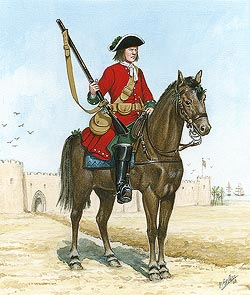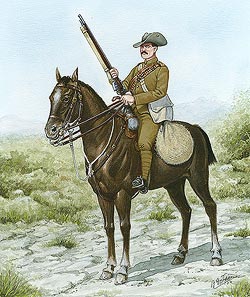Mounted Infantry
 |
| The Tangier Regiment, 1680. A mounted musketeer outside Tangier city walls. |
Although it is recorded that the Queen's Tangier Regiment of Foot had musketeers mounted during their tenure in Tangiers as part of the garrison between 1662 and 1684, little is known of any variations of their dress or equipment from the rest of the regiment. Presumably the musketeers would have been dressed the same as the rest of the regiment with the same accoutrements, possibly with the addition of cavalry boots. Their horses would have been locally bred.
Prior to the inclusion of mounted infantry in the Regular Army, infantrymen had been mounted on ponies, camels and sometimes on the limbers of the Horse Artillery. These had been used more as an experiment and were not continued with, or reorganised, once the necessity for them had passed.
There is a recorded action of a mounted infantry of the 91st Regiment at the Cape, during the surrender of the Dutch fleet at Saldanha Bay in 1796. and later in the Frontier War in 1799-1800.
The first recognition of Mounted Infantry as such was in 1875. South Africa had seen various experiments with mounted infantry and, in 1875, Lieutenant Carrington of the 1/24th raised a small unit 40 strong. He bought the horses and trained them himself. In 1877-78 the 1/24th and the 88th each had a small Mounted Infantry unit fighting the opposition. Carrington moved to the Transvaal and raised two companies each of 150 men divided into two troops. They were drawn from the Buffs, 13th, 1/24th and 94th.
In 1884 a picked force was required for the desert column of the Gordon Relief Force and a Camel Regiment was formed from Mounted Infantry companies on Home and Mediterranean service.
 |
| The East Surrey Regiment, 1900. A mounted Infantryman of the 2nd Battalion in South Africa during the Boer War. |
Mounted Infantry were used in Burma in the 1800’s mounted on small Burmese ponies and, in 1896-97 a strong force was sent to put down a Mashonaland uprising.
Mounted Infantry were taken up, officially, in 1888. Their full development was in 1900 but they were almost extinct by 1914. During their almost 40 years existence they played a considerable part in many small wars and, of course, their major role in the Boer War is well recognised. Even Rudyard Kipling wrote a poem in their honour called simply M.I.
It wasn't until the Boer War that the Queen's and East Surreys were called upon to furnish troops for duties with the Mounted Infantry. The 2nd Battalions of the Queen's and East Surreys sailed to South Africa in October 1899. By November, 1899 eight Companies of Mounted Infantry were formed comprising 1,048 men. It wasn't until November, 1900 that several new Battalions were formed furnished by half companies from each infantry battalion. The 2nd Queen's and 2nd East Surrey each supplied 50 men who, together with the same number from the 1st Durham Light Infantry were designated No 2 Company, 2nd Division, Mounted Infantry.
It wasn't until 26th December that the Company were attacked by 300 Boers who came upon them by chance. Two men were wounded whilst three Boers were killed and another wounded. It is chronicled that "...for a first fight as mounted troops this was most encouraging". During 1901 the Mounted Infantry were well deployed in several expeditions, sometimes working alone and sometimes attached to columns. By July, 1901 the official title had been changed from 2nd Division Mounted Infantry to 26th Battalion Mounted Infantry and they were thus known until disbandment.
In August a report was received of a Boer laager on the move. The Mounted Infantry together with some artillery and some infantry of the 2nd Queen's in wagons set off in pursuit. After a ten mile hard ride they overtook the column and captured twenty-one wagons, ammunition, 1500 head of cattle, 2500 sheep and twenty-one prisoners. Two Boers were killed and eight wagons burnt. A private of the East Surreys was seriously wounded.
During September, during a march to Natal, several East Surrey men were wounded, Major Wiggin and Sergeant Lane rescued, under heavy fire, a comrade who had been seriously wounded. Sergeant Lane was wounded some time later.
By December, the 26th Battalion had made several night raids on farms and captured more prisoners, ammunition and cattle. These attacks and withdrawals continued into 1902 taking many prisoners and much equipment. In March the 2nd East Surrey half company was reinforced and formed a Mounted Infantry company. In August, 1902, at the end of the war the Mounted Infantry was ordered back to Natal and disbanded, the horses handed in and the officers and men returned to their battalions.
A medal for Distinguished Conduct in the Field was awarded to Sergeant Major H G Clay of the East Surreys who was also awarded a very rare Queen's Scarf. This was in the personal gift of the Queen for outstanding bravery in the field.
M.I. I wish my mother could see me now, with a fence-post under my arm, Mount-march, Ikonas! Stand to your ‘orses again! (Rudyard Kipling) |
